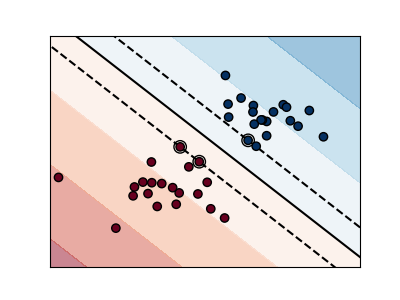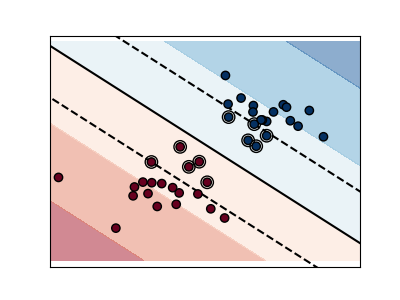支持向量機的邊際?
下圖顯示了參數C對分隔線的影響。 設置較大的C值相當于告訴我們的模型,我們對數據的分布沒有太大的信心,只會考慮更接近分隔線的點。
較小的C值包含更多/所有觀察值,從而可以使用該區域中的所有數據來計算邊距。


輸入:
print(__doc__)
# 源代碼: Ga?l Varoquaux
# 由Jaques Grobler編輯成文檔
# 執照: BSD 3 clause
import numpy as np
import matplotlib.pyplot as plt
from sklearn import svm
# 我們創建40個分離的點
np.random.seed(0)
X = np.r_[np.random.randn(20, 2) - [2, 2], np.random.randn(20, 2) + [2, 2]]
Y = [0] * 20 + [1] * 20
# 圖像的編號
fignum = 1
# 擬合模型
for name, penalty in (('unreg', 1), ('reg', 0.05)):
clf = svm.SVC(kernel='linear', C=penalty)
clf.fit(X, Y)
# 得到分割超平面
w = clf.coef_[0]
a = -w[0] / w[1]
xx = np.linspace(-5, 5)
yy = a * xx - (clf.intercept_[0]) / w[1]
# 繪制與穿過支持向量、與分割超平面平行的平行線(邊際:在垂直于超平面的方向上,平行線遠離超平面的距離)。二維距離垂直方向為sqrt(1 + a ^ 2)。
margin = 1 / np.sqrt(np.sum(clf.coef_ ** 2))
yy_down = yy - np.sqrt(1 + a ** 2) * margin
yy_up = yy + np.sqrt(1 + a ** 2) * margin
# 繪制直線,點和最接近平面的向量
plt.figure(fignum, figsize=(4, 3))
plt.clf()
plt.plot(xx, yy, 'k-')
plt.plot(xx, yy_down, 'k--')
plt.plot(xx, yy_up, 'k--')
plt.scatter(clf.support_vectors_[:, 0], clf.support_vectors_[:, 1], s=80,
facecolors='none', zorder=10, edgecolors='k')
plt.scatter(X[:, 0], X[:, 1], c=Y, zorder=10, cmap=plt.cm.Paired,
edgecolors='k')
plt.axis('tight')
x_min = -4.8
x_max = 4.2
y_min = -6
y_max = 6
XX, YY = np.mgrid[x_min:x_max:200j, y_min:y_max:200j]
Z = clf.predict(np.c_[XX.ravel(), YY.ravel()])
# 將結果放入彩色圖像
Z = Z.reshape(XX.shape)
plt.figure(fignum, figsize=(4, 3))
plt.pcolormesh(XX, YY, Z, cmap=plt.cm.Paired)
plt.xlim(x_min, x_max)
plt.ylim(y_min, y_max)
plt.xticks(())
plt.yticks(())
fignum = fignum + 1
plt.show()
腳本的總運行時間:(0分鐘0.145秒)
